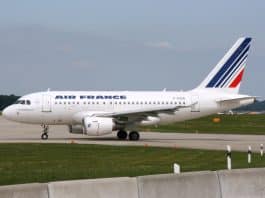Air France-KLM has announced an order for 10 Airbus A350-900s to replace aircraft leaving the fleet in the coming years. A decision that clears up certain grey areas but does not answer all the questions.
Air France-KLM press release
The Boards of Directors of Air France and Air France-KLM have decided on the replacement solution for Air France’s Airbus A380s and approved an order for 10 Airbus A350-900s.
With this decision, Air France-KLM is pursuing its strategy to rationalize and simplify its fleet.
Some of this work has already been done at KLM, which will eventually operate a fleet of long-haul aircraft consisting exclusively of Boeing 777s and 787s. The airline’s pilots are qualified to fly both aircraft.
At Air France, the upcoming order will bring the number of A350s expected to be delivered to 38, of which three have already been delivered.
This is a new step in the deployment of Air France’s fleet simplification strategy. By 2023, the Air France long-haul fleet will comprise 116 aircraft divided into four families: Airbus A330s and A350s, and Boeing 777s and 787s. As at KLM, the expected benefits are greater operational flexibility and economies of scale, thanks in particular to the reduction in the number of pilot qualifications to three by 2023: Airbus A330/A350, Boeing 777 and Boeing 787.
These new generation aircrafts will replace the Airbus A380s currently operated by Air France, which will be retired by the end of 2022. Their arrival will also accelerate the departure of the Airbus A340s in the first quarter of 2021.
[…]
A welcome announcement and rationalization
We are not going to change our minds: this is excellent news for several reasons.
- A fleet based on a reduced number of aircraft types requires fewer qualification types for pilots, which generates savings in training and maintenance and allows more flexibility in assigning them to specific flights.
- Newer aircrafts are more efficient from an economic point of view.
- We are no longer in the dark about what will happen when the A380 and A340 leave the fleet, at least now we know. It’s good to see the airline not remaining in a permanent wait-and-see attitude in the face of structural decisions. It’s good to see the airline not remaining in a permanent wait-and-see attitude in the face of structural decisions.
- I would gladly mention the positive environmental impact of a younger fleet, but objectively speaking, a certain sense of priorities tells me that given the context, the major maneuvers being carried out by the competition and the airline’s financial capacities, Air France’s future in the short term is more worrying than that of the planet.
An unexpected but not so fortuitous announcement
We were so used to seeing Air France procrastinate on issues such as aircraft and cabins (even though these are highly strategic decisions) that we didn’t expect an announcement of this type so soon, however urgent it was. Why ? Although with the arrival of Ben Smith we have noted the will of decide and execute quickly from now on all the subjects without hiding the dust under the carpet, still it is necessary to have the means of it, and the problem of Air France-KLM compared to the other european majors is its available cash.
So wanting to decide if you don’t have the means to execute is just wishful thinking.
Should we see in this decision, in my opinion “ready” for a long time, a consequence of the recently announced non-investment in Virgin Atlantic? The near concomitance of the announcements is too good to be due to chance and this arbitration is a judicious and pragmatic choice.
But we’ll talk about this later…
What the announcement does not say
The interest when you look at an announcement and moreover a press release whose every word is carefully weighed is to find what is not said!
With this order for 10 A350-900s, in addition to a previous order for 28 aircraft of the same type, and taking into account that the A380 fleet consists of 10 aircraft (9 today, as 1 has recently left the fleet) and the A340s of 4, the long-haul fleet will grow to a record size for the airline
On the other hand, given that an A380 has 415 seats compared to 324 for the A350-900, you don’t need to be a math whiz to see that there are almost half a dozen A350s missing to make up the difference in capacity. So an unspoken reduction in long-haul capacity following that of medium-haul with the same logic of replacing A320s with A220s.
Should we complain about it and look for the evil where it is not? Under no circumstances. It is logical that the airline’s communication focuses on elements that are objectively seen as positive by the airline and the general public. Besides that, having more aircraft that allow more flexibility in the constitution of the network and, moreover, easier to fill, will only be good for the airline’s finances, please the markets and finally offer a more interesting offer to customers in terms of number of destinations and/or frequencies.
And the A350-1000 in all this?
But why A350-900s rather than A350-1000s, which in terms of capacity would have left a smaller gap between current and future capacities? Well, in our opinion, not to recreate the situation the airline is trying to get rid of by getting rid of the A380s. The problem of Air France is not the capacity but the profitability. This brings us back to the bottom line of the previous paragraph.
But the subject of the A350-1000 is certainly not buried for long. He’ll just wait for his time. If the A380 and A350 are (finally) settled, although it will take time for the 38 aircraft to join the fleet (we do not have a complete timetable to date), the question of the B777-200 and B777-300ER will soon arise.
25 B777-200s are 17 years or older, the oldest B777-300ER will be 16 years old. When we know how long it takes to make a decision and to receive the planes, it is a subject on which a decision will have to be made rather quickly, the most complicated being that this decision makes sense today but also in 15 or 20 years! And there is no question of doing it piecemeal: it is an overall strategy that must be determined.
Here we have two obvious candidates: the A350 and the B777X. But in which version?
Before, everything would have been clear: B777-9s to replace the -300s and A350-900s or 1000s for the -200s (the B777-8 seems a bit of a bastard in the story). This allows for consistency in terms of capabilities and ensures that you don’t put all your eggs in one basket.
Yes, but…
It is urgent to wait, but not too much
The B777X program is behind schedule and is experiencing problems that the B737 MAX affair requires to be taken very seriously.
On the other hand, the A350-1000 has just been certified for 480 passengers, 40 more than the original certification. This makes it a credible option for those who saw only the 777-9 as a future very large long-haul aircraft.
In short, this will be Air France’s next key decision, and it will be far more structuring when we know what it owes today to the 777 and the 300ER in particular.
Our bet? A mix of A350-900s, A350-1000s (not pushed to their maximum capacity) and 777-9s. In what proportions? The guarantees that the 777X program will provide, or not, in the coming months will tell. Air France can still wait a year or two before making up its mind, and given the uncertainty about the future forces in this niche, it may be urgent to wait. But not too much.





















